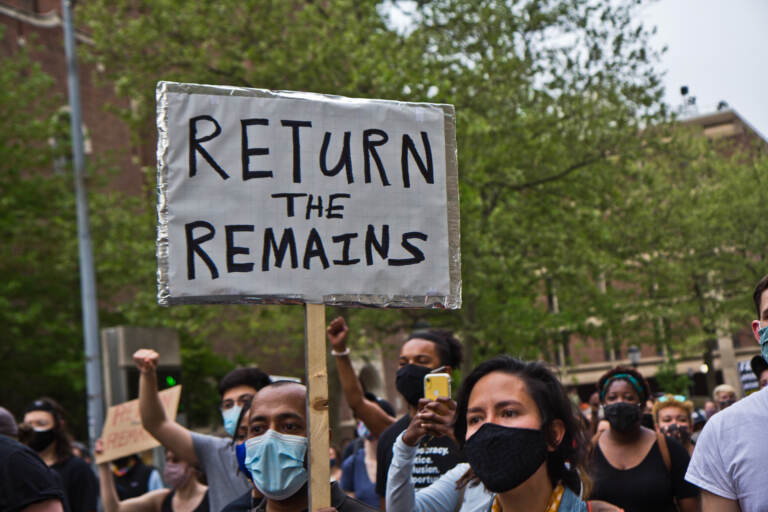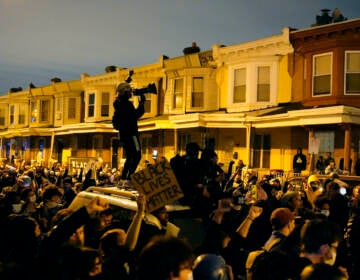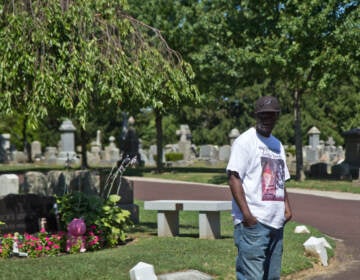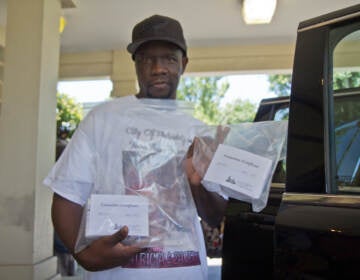Philly releases independent report on city’s mishandling of MOVE bombing victims’ remains
The report focused on the city’s possession of human remains from the 1985 MOVE bombing and the policies and procedures of the city’s Medical Examiner’s Office.

Protesters marched on the University of Pennsylvania’s Campus on April 28, 2021, over the Penn Museum's mishandling of MOVE bombing victim remains. (Kimberly Paynter/WHYY)
Philadelphia released an independent report Thursday focused on the city’s possession of human remains from the 1985 MOVE bombing and the procedures of the city’s Medical Examiner’s Office.
The city first announced that it would conduct the investigation more than a year ago.
“While I know the reports did not answer every question we have around the remains we found last year, I remain hopeful that we can give some additional comfort and closure to family members after they review the report and we discuss our next steps with them,” Mayor Jim Kenney said in a statement announcing the conclusion of the investigation.
Two outside law firms, Dechert LLP and Montgomery McCracken Walker & Rhoads LLP were tapped to lead the investigation. Dechert’s piece of the inquiry dealt with the handling of the human remains from 1985 all the way to the present day.
It also examined the “contemporary evidence” related to the remains such as the destruction of the toxicology samples from victims in 2009 to the discovery of the Medical Examiner’s Office Box.
MMWR’s research analyzed the policies within the MEO and made recommendations from a racial equity lens. The investigation also detailed how some of the remains were transferred to Dr. Alan Mann and Dr. Janet Monge, “anthropologists associated with the University of Pennsylvania and Princeton University, in 1986, that were later discovered to still be in Dr. Monge’s possession.”
The combined investigative report, however, emphasized that there were limitations. Because the law firms lacked the ability to compel interview subjects to speak, several “key witnesses” refused to cooperate even though they knew they were the only source of the information.
Regarding the documentation and retrieval of the remains, the probe found numerous inconsistencies and contradictions with MEO files. There were no logs detailing whether remains released by the MEO were received by funeral homes and cemeteries.
“As a result, we are unable to conclude definitively what remains, if any, were released for the respective victims and actually buried or cremated between May 1985 and September 1986, when the last of the victims’ remains were purportedly formally released to the families,” the report said.
Because of the manner by which the scene was processed and MEO’s failure to visit the scene in the aftermath of the bombing, the ability to establish a chain of custody of the remains was “doomed from the beginning.”
In the review of the months and years that followed the bombing, the law firms established a rough timeline of the transfer of human remains. Yet, because a key former MEO pathologist declined to participate, many questions were left unanswered.
When the box containing the human remains of MOVE members was found in 2017, an MEO employee notified his supervisors including then-Chief Medical Examiner Dr. Sam Gulino — who would then go on to notify former Deputy Commissioner Dr. Caroline Johnson and former Health Commissioner Dr. Thomas Farley. Farley resigned in 2021 over his involvement in mishandling the remains.
According to the investigation, Farley ordered Gulino to retain the remains for six months and then have them cremated.
“Dr. Farley never saw, and never asked to see, the human remains in the MEO Box, despite recognizing the significance of the fact that City had in its possession remains that were linked to the MOVE bombing decades after the bombing. He also did not advise his superiors, including the Managing Director, or the Mayor’s Office, about the presence of the remains in the MEO Box,” the report said.
The box would later be discovered in a cold storage room in May 2021 even though there was apparently a record of its destruction.
Although the law firms repeatedly tried to reach out to the city employee tasked with cremating the remains, their requests were denied.
“Therefore, we do not know why the remains were not cremated, and when, why, or by whom they were brought to the cold storage room in the first instance,” the report said.
Ultimately, the investigation was unable to determine how long the box had been in that basement storage room before January 2017 and who put it there.
“Finally, we cannot determine why the remains were kept by the MEO and not returned to next of kin,” the report said.
Many of the individuals interviewed including former Mayor W. Wilson Goode Sr., MOVE Commission members, and others “expressed shock and disbelief” that the city was still in possession of the remains.
Even though the city never requested any recommendations as part of the report, the law firms felt that it was appropriate to do so.
The firms recommended that there be a “concerted, inclusive effort” to educate city residents about the MOVE bombing, its victims, and the impact it had on the surrounding community. Additionally, the report calls for a “physical commemoration of this historical event.”
After being unnerved that the five child victims of the MOVE bombing were buried in unmarked graves, the investigators believe that there should be a marker or memorial at Eden Cemetery.
Lastly, the report asks that whoever is charged with the duty of identifying the remains from the MEO box use the investigation as a springboard.
“In other words, though we have not formally identified those remains and though such identification is beyond the scope of our engagement, we believe the information contained here will be valuable and relevant to any subsequent analysis,” the report said.
Among the 16 recommendations for the MEO, two are that the MEO amend the death certificates of all 11 MOVE bombing victims to update the cause of death, and reflect that the manner of death was homicide and not accident.
The MEO plans to do so.
Kenney said that he was grateful for the investigative teams and their work.
“The tragedy of the MOVE bombing in 1985 and the decades-long trauma it has inflicted on family members, neighbors, and city residents is something that we will never completely heal from,” Kenney said. “The events of 2021 exposed flaws and shortcomings in city procedures, and the passage of decades since the initial mishandling of the victim’s remains compounded the issues we were faced with and had to try and unravel.”
Philadelphia Health Commissioner Dr. Cheryl Bettigole echoed that sentiment in a statement, while also outlining some of the expected hurdles in following through with all of the recommendations
“Some of the changes recommended are already in process, while others may be more challenging to implement due to funding or logistical constraints. In addition to the changes recommended by the investigators, we are committed to working with the families of the victims to identify a respectful plan for how to handle the remains and will be reaching out in the near future to initiate those conversations,” Bettigole said.
The Philadelphia Department of Public Health and the MEO issued a response to the investigation.
WHYY is your source for fact-based, in-depth journalism and information. As a nonprofit organization, we rely on financial support from readers like you. Please give today.







